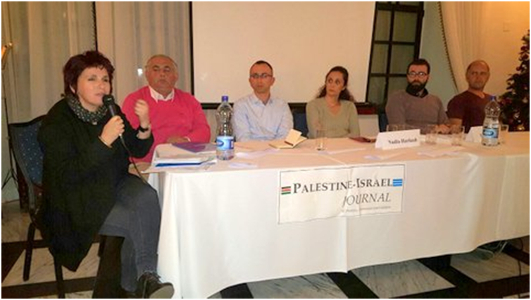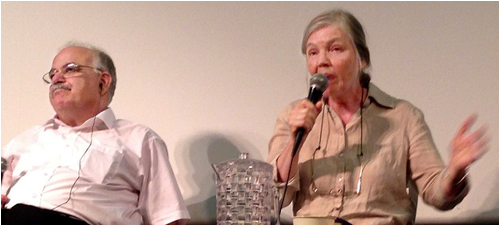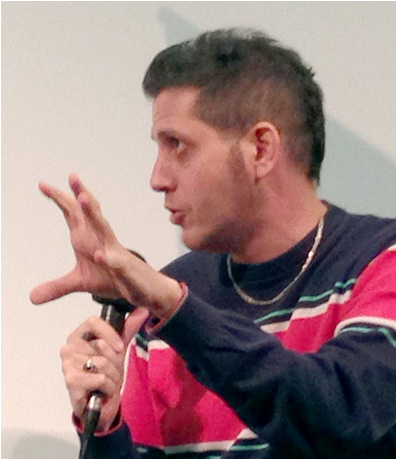“Jerusalem belongs to both nations. No exclusive claim is sustainable,” Yudith Oppenheimer said simply in reply to the question, “Who does the city belong to?”
Oppenheimer was speaking at a conference focusing on the centrality of the Holy City to the protracted conflict between Israelis and Palestinians. The conference, aptly named Jerusalem: The Core of the Conflict, and organized by the Heinrich Böll Foundation Israel office, was held on the evening of June 15th at the Jerusalem Cinematheque. Guest speakers included an array of personalities from differing academic fields and professional backgrounds. After the opening remarks from the director of the foundation, Kerstin Müller, the moderator for the evening, Peter Kapern, introduced the five panelists: Yudith Oppenheimer, executive director of Ir Amim, a non-profit organization focusing on Jerusalem within the context of the conflict, Prof. Raphael Greenberg of the Department of Archaeology and Ancient Near Eastern Cultures at Tel-Aviv University, writer Lea Fleischmann, noted young Israeli author Nir Baram, , and finally Elias Khouri, a renowned Palestinian lawyer and activist.

Moderator Peter Kapern tosses the first question, "Who does Jerusalem belong to?" to Yudith Oppenheimer, executive director of non-profit Ir Amim. (Photo: Patricia Cordell)
Jerusalem is defined by its people
When moderator Kapern addressed Oppenheimer with the opening question on the importance of sovereignty over Jerusalem for both nations, it was clear straight away from her reply that any discussion on the centrality of the city in the context of the conflict is undoubtedly, and unavoidably connected to other, wider and more important issues than mere control over the Jerusalem itself. As Oppenheimer poignantly pointed out, the question at hand is not who the city belongs to, but “what kind of life we can share in Jerusalem?”
Prof. Greenberg echoed these sentiments, arguing “Jerusalem belongs to its people.” He made the important point that Jerusalem is completely different from how leaders try to rhetorically frame the city in regards to their own political aspirations; a view which stemmed from Kapern’s attempt to uncover a simple narrative which may underlie the conflict’s convoluted discourse. In reply to Kapern’s question, Elias Khouri argued Israeli dominance has grown steadily since 1967, and as result, this has driven a wedge between the two communities, as Palestinian rights are persistently negated in order to tighten Israel’s grip on East Jerusalem. What was apparent from all of these comments from the panellists was that Jerusalem has always been the home of Christians, Jews, and Muslims; members of all three monotheistic religions have for generations lived side by side, and it was in fact the intensification of the conflict since 1967 which had actually polarized the communities and fostered the zero-sum rhetoric which currently characterizes the conflict.
The Possibility of violence
Towards the end of his first reply to Kapern’s question on the underlining aspect of the Jerusalem issue, Khouri foresaw an even greater violent uprising than the two previous Intifadas, if the present situation of persistent marginalization continues. To this Kapern asked German-born author Lea Fleischmann now living in the city, if she agreed with these predictions on whether Jerusalem could again erupt into outright violence. In contrast to the previous comments, Fleischmann argued violence had erupted in the past, not as a result of Israeli occupation, but more from a collective Arab dissatisfaction with Palestinian leadership. She accused the Palestinian Authority (PA) of systemic corruption and lack of democratic initiative, and highlighted this as the main hindrance to Palestinian statehood. This provoked fellow panelist Nir Baram to vehemently reject this view, stating, “To say the Intifada was because of Palestinian leadership is to be ignorant of the situation on the ground.”

Palestinian attorney Elias Khouri reacts to Lea Fleischman's comment that Arab dissatisfaction stems from Palestinian leadership.(Photo: Patricia Cordell)
Looking at ourselves
In this simmering atmosphere of mounting tension, Kapern attempted to redirect the discussion back to the topic at hand, namely Jerusalem, to which Oppenheimer again reaffirmed succinctly that the city is home to “two nations and three religions.” The situation currently, she argued, was the complete responsibility of the Israeli authorities since they control the area, and the Israeli government does not allow the PA to have any authority in East Jerusalem.
In another poignant remark, she commented how the residents in the predominantly Jewish parts of the city are becoming frighteningly accustomed to the state of marginalization in the city. “We don’t think about it,” she lamented. Oppenheimer’s view paralleled that of Rabbi Michael Melchior who in a conference two days previously, launching of Rabbi Kronish’s forthcoming publication Reconciliation and Co-existence in Israel, argued we need to “Take up the mirror to ourselves.” Like Oppenheimer, Rabbi Melchior’s main point was people are reluctant to face the severity and contradictions in their present reality, adding “We don’t come up with the difficult statements and actions.”
It is only by walking the streets of Jerusalem and exploring its neighbourhoods that Oppenheimer’s and Rabbi Melchior’s words begin to ring true. Since arriving, I have been struck by how the situation reflects what the two activists say. Walking from my accommodation in leafy Rehavia in West Jerusalem, I never fail to be amazed at how the landscape and feeling of the city suddenly switches by the time I reach Damascus Gate on the way to the PIJ office. Gone are the well-polished streets. Gone is the well-maintained and idyllic infrastructure. Gone are the open green park spaces on my short walk down the other side of Azza Street. And in their place there are dusty road-side buildings, barely standing and in dire need of restoration. Alongside this landscape a pronounced police presence also becomes unmistakeably visible. This is not to say that the eastern part of the city does not have its own charm or characters, for on the contrary it has this in abundance, but what it does highlight is exactly what Elias Khouri maintained throughout the debate; that no institution in Israel is dedicated to the needs of the Palestinian population in East Jerusalem.
Future Solutions
Towards the end of the discussion, Kerpan probed Baram on his view that the European "obsession" with the two-state solution overlooks the reality on the ground. Baram, despite his scepticism regarding the viability of the two-state solution, said he was “in favor of any solutions that work”. To this he outlined three possibilities: a two-state solution, which in his opinion is not great, a one state solution which would in theory require very little change in the current situation, just the rebalancing of social equality between Israelis and Palestinians, and a more revolutionary proposal of two states in one space characterized by the ability of free movement between states of citizens of either nation. Although Oppenheimer is a staunch two-state solution advocate, this final proposal was not explored in any depth because of a lack of time. It pertained to the very ideas Oppenheimer had maintained throughout the discussion, and which is often overlooked time and time again when considering the centrality of Jerusalem in the conflict. That is, it belongs to no one but everyone.

Despite his scepticism regarding the viability of the two-state solution, author Nir Baram said he was “in favor of any solutions that work”. (Photo: Patricia Cordell)
